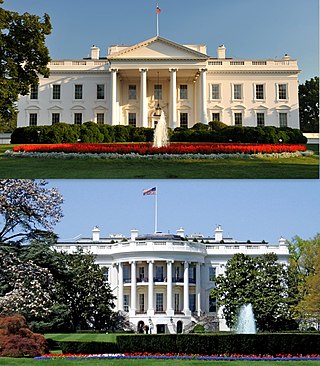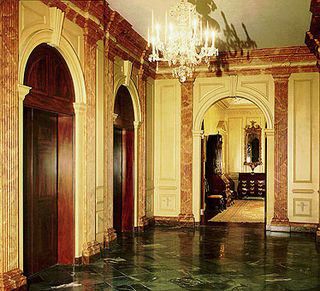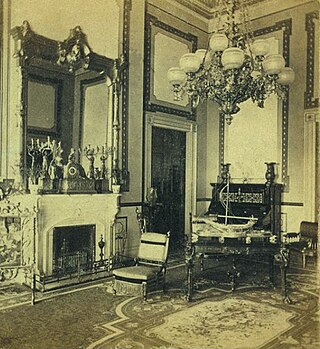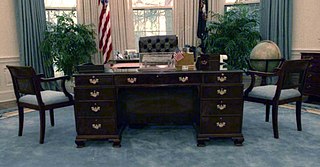
The United States Department of State (DOS), or simply the State Department, is an executive department of the U.S. federal government responsible for the country's foreign policy and relations. Equivalent to the ministry of foreign affairs of other nations, its primary duties are advising the U.S. president on international relations, administering diplomatic missions, negotiating international treaties and agreements, and representing the U.S. at the United Nations. The department is headquartered in the Harry S Truman Building, a few blocks from the White House, in the Foggy Bottom neighborhood of Washington, D.C.; "Foggy Bottom" is thus sometimes used as a metonym.

The White House is the official residence and workplace of the president of the United States. It is located at 1600 Pennsylvania Avenue NW in Washington, D.C., and has been the residence of every U.S. president since John Adams in 1800 when the national capital was moved from Philadelphia to Washington, D.C. The term "White House" is often used as metonymy for the president and his advisers.

The Cosmos Club is a 501(c)(7) private social club in Washington, D.C., that was founded by John Wesley Powell in 1878 as a gentlemen's club for those interested in science. Among its stated goals is, "The advancement of its members in science, literature, and art and also their mutual improvement by social intercourse."

The James Madison Memorial Building is one of three United States Capitol Complex buildings that house the Library of Congress. The building was constructed from 1971 to 1976, and serves as the official memorial to United States Founding Father and president James Madison. It is located between First and Second Streets SE on Independence Avenue, across for the main library Thomas Jefferson Building, in Washington, D.C. In addition to various book and multimedia collections, it houses the United States Copyright Office, which is under the administration of the Librarian of Congress.

Edward Vason Jones, a neoclassical architect and member of the Georgia School of Classicism, began his career in 1936 with the design and construction of the Gillionville Plantation near his hometown of Albany, Georgia. The project impressed Hal Hentz of the well-known Atlanta firm of Hentz, Reid, and Adler so much that he hired Vason Jones as draftsman and superintendent of construction, despite his lack of formal training in architecture.

The Blue Room is one of three state parlors on the first floor in the White House, the residence of the president of the United States. It is distinctive for its oval shape. The room is used for receptions and receiving lines and is occasionally set for small dinners. President Grover Cleveland married Frances Folsom in the room on June 2, 1886, the only wedding of a President and First Lady in the White House. The room is traditionally decorated in shades of blue. With the Yellow Oval Room above it and the Diplomatic Reception Room below it, the Blue Room is one of three oval rooms in James Hoban's original design for the White House.

The Red Room is one of three state parlors on the State Floor in the White House, the Washington D.C. home of the president of the United States. The room has served as a parlor and music room, and recent presidents have held small dinner parties in it. It has been traditionally decorated in shades of red. The room is approximately 28 by 22.5 feet. It has six doors, which open into the Cross Hall, Blue Room, South Portico, and State Dining Room.

The Green Room is one of three state parlors on the first floor of the White House, the home of the president of the United States. It is used for small receptions and teas. During a state dinner, guests are served cocktails in the three state parlors before the president, first lady, and a visiting head of state descend the Grand Staircase for dinner. The room is traditionally decorated in shades of green. The room is approximately 28 by 22.5 feet. It has six doors, which open into the Cross Hall, East Room, South Portico, and Blue Room.

The State Dining Room is the larger of two dining rooms on the State Floor of the Executive Residence of the White House, the home of the president of the United States in Washington, D.C. It is used for receptions, luncheons, larger formal dinners, and state dinners for visiting heads of state on state visits. The room seats 140 and measures approximately 48 by 36 feet.

The China Room is one of the rooms on the Ground Floor of the White House, the home of the president of the United States. The White House's collection of state china is displayed there. The collection ranges from George Washington's Chinese export china to Barack Obama's blue and white themed collection. Almost all administrations are represented with a collection; however, a few are not - most recently, the Trump administration did not have a collection created and instead mainly used the china designed by Hillary Clinton during her time as First Lady. The room is primarily used by the first lady for teas, meetings, and smaller receptions.

The Octagon House, also known as the Colonel John Tayloe III House, is a house located at 1799 New York Avenue, Northwest in the Foggy Bottom neighborhood of Washington, D.C. It was built in 1799 for John Tayloe III. In September 1814, after the British destroyed the White House during the War of 1812, for six months the Octagon House served as the residence of United States president James Madison and first lady Dolley Madison. It is one of only five houses to serve as the presidential residence in the history of the United States of America, and one of only three that still stand.

The Yellow Oval Room is an oval room located on the south side of the second floor in the White House, the official residence of the president of the United States. First used as a drawing room in the John Adams administration, it has been used as a library, office, and family parlor. Today the Yellow Oval Room is used for small receptions and for greeting heads of state immediately before a State Dinner.

The Executive Residence is the central building of the White House complex located between the East Wing and West Wing. It is the most recognizable part of the complex, being the actual "house" part of the White House. This central building, first constructed from 1792 to 1800, is home to the president of the United States and the first family. The Executive Residence primarily occupies four floors: the ground floor, the state floor, the second floor, and the third floor. A two-story sub-basement with mezzanine, created during the 1948–1952 Truman reconstruction, is used for HVAC and mechanical systems, storage, and service areas.

Barboursville is the ruin of the mansion of James Barbour, located in Barboursville, Virginia. He was the former U.S. Senator, U.S. Secretary of War, and Virginia Governor. It is now within the property of Barboursville Vineyards. The house was designed by Thomas Jefferson, president of the United States and Barbour's friend and political ally. The ruin is listed on the National Register of Historic Places.

Save America's Treasures is a United States federal government initiative to preserve and protect historic buildings, arts, and published works. It is a public–private partnership between the U.S. National Park Service and the National Trust for Historic Preservation. The National Endowment for the Arts, National Endowment for the Humanities, and Institute of Museum and Library Services are also partners in the work. In the early years of the program, Heritage Preservation and the National Park Foundation were also involved.

The Harry S Truman Building is the headquarters of the United States Department of State. It is located in Washington, D.C., and houses the office of the United States secretary of state.

Clement Ellis Conger was an American museum curator and public servant. He served as director of the U.S. Department of State Office of Fine Arts, where in that role he worked as curator of both the Diplomatic Reception Rooms and Blair House. He also served as Curator of the White House, at the pleasure of Presidents Nixon, Ford, Carter, and Reagan. Prior to working as a curator, Conger served as a Foreign Service Officer, as the Deputy Chief of Protocol of the United States and as the Assistant Secretary of the Combined Chiefs of Staff.

The C&O desk is one of six desks ever used in the Oval Office by a sitting President of the United States. The C&O Desk was used in the executive office by only George H. W. Bush, making it one of two Oval Office desks to be used by only one president there. Prior to its use in the Oval Office by Bush, the desk had been in use elsewhere in the White House. It is the shortest-serving Oval Office desk to date, having been used for one four-year term.

The Office of Fine Arts (M/FA) is a division of the U.S. Department of State reporting to the Under Secretary of State for Management. The mission of the office is to administer appropriate settings for dialogue between U.S. officials and their international guests, to illustrate the continuity of American diplomacy through relevant objects, and to celebrate American cultural heritage through the acquisition, preservation and display of works of art with people around the world.

Edmund Stuart Bittinger, better known by Ned Bittinger, is an American portrait painter and illustrator whose works include the Congressional portraits of Abraham Lincoln and Lindy Boggs for the United States Capitol, as well as Secretaries of State James Baker and Lawrence Eagleburger's official State Department portraits.































